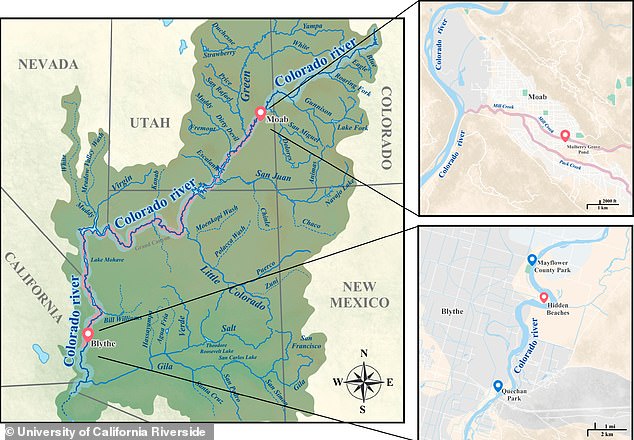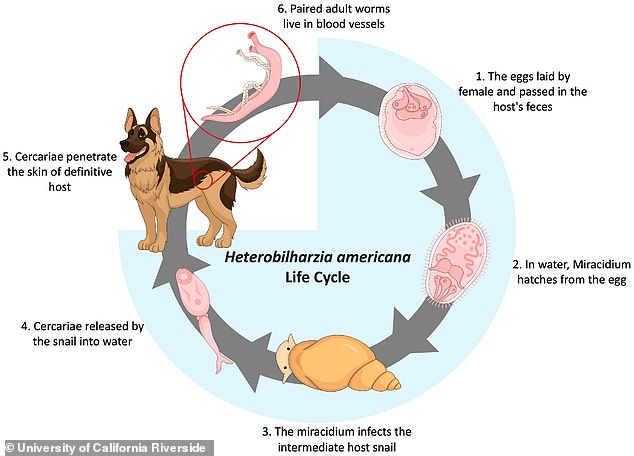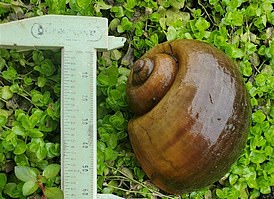Dog-killing worms found for the first time in California: Scientists discover hundreds of snails in the Colorado River harboring the parasite that has killed at least one pet
Scientists have discovered dog-killing worms for the first time in Southern California, which have infected at least 11 pets, one of which has died.
A team from the University of California Riverside (UCR) discovered that Heterobilharzia americana, a flatworm commonly called liver fluke, is transmitted by snails living along the Colorado Riverbed.
The worms can cause schistosomiasis in dogs, a disease that affects the liver and intestines of dogs and was previously only found in Texas, Louisiana and Florida.
The findings have suggested that the small flatworms could be spreading throughout the Colorado River and smaller rivers that feed into it, creating a wider expansion than previously known.
A team from the University of California Riverside (UCR) found that Heterobilharzia americana, a flatworm commonly called liver fluke, was transmitted by snails along the Colorado Riverbed.
UCR nematology professor Adler Dillman said, ‘Dogs can die from this infection, so we hope to raise public awareness that it is there.
“If you swim with them in the Colorado River, your pets are at risk.”
Los Angeles County of Public Health issued an advisory in 2023 confirming 11 cases of canine schistosomiasis spanning from 2018 to 2023.
Dillman and his team got wind of the local infections and went to a part of the river where all eleven dogs were swimming.
The team collected more than 2,000 snails and found two species that harbor flatworms: Galba cubensis and Galba humilis.
“Not only was it a surprise to find H. americana, we didn’t know the snails were here,” Dillman said

This discovery was made at Mulberry Grove Pond, which receives water from Mill Creek, one of the tributaries of the Colorado River.

After transforming itself into one of the snails, the worm ventures out to find a mammal to infect. In this stage he can only survive for about 24 hours. If a dog or raccoon sits in or drinks water, it becomes infected
Galba cubensis was previously believed to be the worm’s only natural host, with G. humilis showing only marginal susceptibility.
Both snails are mainly from the Americas, but have invaded Asia, Europe and Africa.
“This discovery was made at Mulberry Grove Pond, which receives water from Mill Creek, one of the tributaries of the Colorado River,” the researchers shared in the study.
“This pond is approximately 250 feet from Mill Creek, and the Colorado River bank is approximately 2.25 miles from the pond.”
However, the team thinks the parasite could spread across the Colorado River and take advantage of the rivers that flow into it to find new hosts.
“In-depth studies are needed to investigate the extent of parasite infestation along the banks of the Colorado River and its tributaries in the United States and Mexico to gain a clear understanding of parasite infection,” it reads research.

The team collected more than 2,000 snails and found two species that harbor flatworms: Galba cubensis and Galba humilis
After transforming itself into one of the snails, the worm ventures out to find a mammal to infect.
In this stage he can only survive for about 24 hours. If a dog or raccoon sits in or drinks water, it becomes infected.
“It ends up in the veins of the intestinal wall, and that’s where it develops into an adult and mates,” Dillman said.
‘The presence of the adults in the veins is not the problem. It is the eggs that end up in the lungs, spleen, liver and heart. The immune system tries to deal with it and hard clusters of immune cells called granulomas form. Eventually the organ tissues stop functioning.’
Once infected, it can take several months for the worst symptoms of the disease to appear.
Emily Beeler, a veterinarian with the Los Angeles County Department of Public Health, said: ‘Symptoms begin gradually with a loss of appetite and eventually include vomiting, diarrhea, severe weight loss and signs of liver disease.
“If your dog has these symptoms after swimming in the Colorado River, it is a good precaution to ask your vet for a simple stool test.”
“Treatment typically involves the use of multiple medications and close supervision of the dog by a veterinarian,” Beeler said.
Researchers emphasized that H. americana is not known to cause disease in humans.
‘It can cause swimmer’s itch, a red rash where it penetrates human skin. But it cannot cause infection,” Dillman said, also noting that the worms can be easily filtered from water systems.

